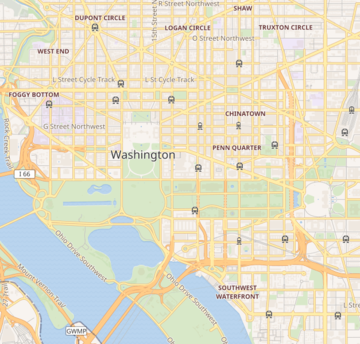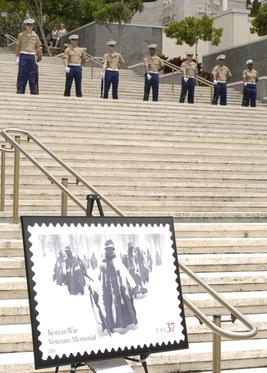Korean War Veterans Memorial
|
Korean War Veterans Memorial | |
 | |
|
Aerial view of the Korean War Veterans Memorial | |
|
| |
| Location | SE of Lincoln Memorial, off Independence Ave., Washington DC |
|---|---|
| Coordinates | 38°53′16″N 77°2′50″W / 38.88778°N 77.04722°W / 38.88778; -77.04722Coordinates: 38°53′16″N 77°2′50″W / 38.88778°N 77.04722°W / 38.88778; -77.04722 |
| Area | 2.20 acres (0.89 ha) |
| Visitation | 3,214,467 (2005) |
| Governing body | National Park Service |
| NRHP Reference # | 01000273[1] |
| Added to NRHP | July 27, 1995 |
The Korean War Veterans Memorial is located in Washington, D.C.'s West Potomac Park, southeast of the Lincoln Memorial and just south of the Reflecting Pool on the National Mall. It commemorates those who served in the Korean War.
Contents
[show]
Design and construction[edit]
The Veterans Memorial was confirmed by the U.S. Congress (Public Law 99-572) on October 28, 1986,[2] with design and construction managed by the Korean War Veterans Memorial Advisory Board and the American Battle Monuments Commission.
The initial design competition was won in 1986 by a team of four architects from The Pennsylvania State University, but this team withdrew as it became clear that changes would be needed to satisfy the advisory board and reviewing agencies such as the Commission of Fine Arts. A federal court case was filed and lost over the design changes. The eventual design was by Cooper-Lecky Architects who oversaw collaboration between several designers.[3]
President George H. W. Bush conducted the groundbreaking for the Memorial on June 14, 1992, Flag Day. The companies and organizations involved in the construction are listed on the memorial as: the Faith Construction company, the R. J. Crowley company, the Cold Spring Granite Company, the Tallix Art Foundry and the Baltimore District of the US Army Corps of Engineers.... The memorial was dedicated on July 27, 1995, the 42nd anniversary of the armistice that ended the war, by President Bill Clinton and Kim Young Sam, President of the Republic of Korea, to the men and women who served during the conflict. Management of the memorial was turned over to the National Park Service, under its National Mall and Memorial Parks group. As with all National Park Service historic areas, the memorial was administratively listed on the National Register of Historic Places on the day of its dedication.
Memorial[edit]
The main memorial is in the form of a triangle intersecting a circle. Walls: 164 feet (50 m) long, 8 inches (200 mm) thick; more than 100 tons of highly polished "Academy Black" granite from California: more than 2,500 photographic, archival images representing the land, sea and air troops who supported those who fought in the war are sandblasted onto the wall.
Within the walled triangle are 19 stainless steel statues designed by Frank Gaylord,[4] each larger than life-size, between 7 feet 3 inches (2.21 m) and 7 feet 6 inches (2.29 m) tall; each weighs nearly 1,000 pounds (500 kg). The figures represent a squad on patrol, drawn from each branch of the armed forces; fourteen of the figures are from the U.S. Army, three are from the Marine Corps, one is a Navy Corpsman, and one is an Air Force Forward Air Observer. They are dressed in full combat gear, dispersed among strips of granite and juniper bushes which represent the rugged terrain of Korea.[5]
When reflected on the wall, there appear to be 38 soldiers, representing the 38th parallel. To the north of the statues is a path, forming one side of the triangle. Behind, to the south, is a 164-foot-long black granite wall, created by Louis Nelson, with photographic images sandblasted into it depicting soldiers, equipment and people involved in the war. This forms the second side of the triangle. The third side of the triangle, facing towards the Lincoln Memorial, is open.
To the north of the statues and path is the United Nations Wall, a low wall listing the 22 members of the United Nations that contributed troops or medical support to the Korean war effort.
The circle contains the Pool of Remembrance, a shallow pool 30 feet (9 m) in diameter lined with black granite and surrounded by a grove of linden trees with benches. The trees are shaped to create a barrel effect, which allows the sun to reflect on the pool.[6] Inscriptions list the numbers killed, wounded, missing in action, and held as prisoners of war, and a nearby plaque in inscribed: "Our nation honors her sons and daughters who answered the call to defend a country they never knew and a people they never met." Additionally, right next to the numbers of American soldiers are those of the United Nations troops in the same categories. In the south side of the memorial, there are three bushes of the Rose of Sharon hibiscus plant, South Korea's national flower.
A further granite wall bears the simple message, inlaid in silver: "Freedom Is Not Free."
Troop statistics[edit]
Engraved on granite blocks near the water pool at the east end of the monument are the casualty statistics for the soldiers who fought in the war.
- Dead — United States: 54,246,[7] United Nations: 628,833[8]
- Wounded — United States: 103,284, United Nations: 1,064,453.
- Captured — United States: 7,140, United Nations: 92,970.
- Missing — United States: 8,177,[9] United Nations: 470,267.
United States postage stamp court case[edit]
On February 25, 2010, the United States Court of Appeals for the Federal Circuit ruled on appeal that the memorial sculptor Frank Gaylord was entitled to compensation for a 37 cent postage stamp which used an image of the sculpture because he had not signed away his intellectual property rights to the sculpture when it was erected. The appeals court rejected arguments that the photo was transformative.[10]
In 2002, amateur photographer and retired Marine John Alli was paid $1,500 to use one of his photographs of the memorial on a snowy day for the stamp[11] which sold more than $17 million worth of stamps. In 2006 sculptor Frank Gaylord enlisted Fish & Richardson to make a pro bono claim that the Postal Service had violated his Intellectual property rights to the sculpture and thus should have been compensated. The Postal Service argued that Gaylord was not the sole sculptor (saying he had received advice from federal sources – who recommended that the uniforms appear more in the wind) and also that the sculpture was actually architecture. Gaylord won all of his arguments in the lower court except for one—the court ruled the photo was fair use and thus he was not entitled to compensation.[12] Gaylord challenged the fair use ruling and won the case on appeal. The case could now either be appealed to the United States Supreme Court, or damages could be assessed by the United States Court of Federal Claims.[10]
Gaylord had sought compensation of 10 percent of the sales. Gaylord's original commission was $775,000.[13] on April 22, 2011, The US Court of Claims awarded Gaylord $5,000.[14] on September 20, 2013, The United States Court of Federal Claims awarded Gaylord $684,844.94 in damages.[15]
See also[edit]
'Washington, D.C.' 카테고리의 다른 글
| PETITION TO THE U.S. HOUSE OF REPRESENTATIVES (0) | 2015.06.10 |
|---|---|
| Jefferson Memorial (0) | 2014.10.25 |
| Lincoln Memorial (0) | 2014.10.24 |
| Basilica of the National Shrine of the Immaculate Conception (1) | 2013.08.30 |
| Washington, D.C. (0) | 2013.05.07 |


